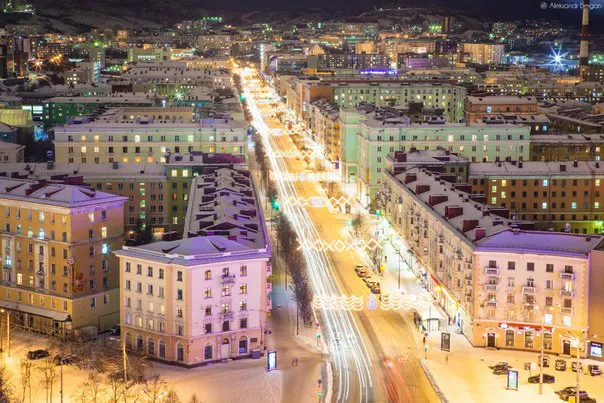Summary
Murmansk is the largest city in the world above the Arctic Circle and serves as the administrative center of Murmansk Oblast. This city holds immense historical and cultural importance, particularly due to its military and trade significance during World War II. Additionally, it stands as a remarkably preserved example of Post-Communist Russia, having undergone minimal transformations since the Communist Era.
A Brief History
Established in 1915 when the Russian railway system expanded northward, Murmansk is the last city founded in the Russian Empire. Throughout World War II, it emerged as one of the country’s most pivotal ports for manufacturing and trading supplies.
During the conflict, Hitler’s army heavily bombed Murmansk; the only Russian city that endured more attacks was Stalingrad. Despite suffering enormous destruction, Murmansk remained unconquered, earning the prestigious title of “Hero City” for its steadfast defense against the German army.
In the Cold War era, Murmansk became a base for Soviet nuclear icebreakers and submarines, many of which continue to be housed there. Today, it functions as a port for fishing activities, exports, and passenger vessels.
Since the fall of the Soviet Union in 1989, Murmansk has experience a significant population decline, with current estimates around 304,500 residents.
Visiting Murmansk

There are two effective ways to reach Murmansk:
- By Train: Regular train services connect Murmansk with St. Petersburg, Moscow, and other significant cities. However, given its remote location, the journey can be extensive, taking approximately 32 hours from St. Petersburg.
- By Airplane: Direct flights to Murmansk Airport are available from St. Petersburg, Moscow, and Helsinki.
Where to Stay in Murmansk
Visitors can opt for the historic 3-star Hotel Artika located in the city center or stay nearby at the Hotel Meridian, which is also a well-rated 3-star establishment on Five Corners Square. An additional premium option includes the 4-star Park Inn Poliarnie Zori, known for its central location.
Weather in Murmansk
Despite its northern latitude, Murmansk experiences relatively temperate weather. Winter temperatures typically average around -10 degrees Celsius, while summer temperatures hover around 12 degrees, with some rainfall. Notably, polar nights persist from December 2 to January 11, while polar days occur from May 2 to July 22.
During winter, you might have the opportunity to witness the magnificent Northern Lights, which are visible about 15 to 20 times throughout the season.
Murmansk Sights and Attractions

While exploring Murmansk, you will encounter numerous statues and memorials. Here are some notable attractions:
- The Alyosha Monument: This significant war memorial, standing 116 feet tall, honors the “Defenders of the Soviet Arctic during the Great Patriotic War” (World War II).
- St. Nicholas Church: A modest yet noteworthy Russian Orthodox church dedicated to the patron saint of sailors, accompanied by a commemorative lighthouse nearby.
- The Square of Five Corners: The heart of Murmansk, featuring the DUMA, the primary shopping center, and the Hotel Arktika.
- The Hotel Arktika: Once the tallest building above the Arctic Circle upon completion, it stands at 16 stories due to stability concerns in the cold climate. The hotel welcomes tourist visits.
Museums
- The Museum of Regional History: This museum showcases four floors dedicated to the history and culture of the region, featuring captivating nature and animal displays that are family-friendly.
- The Fine Arts Museum: The only art museum situated above the Arctic Circle, this establishment displays over 3000 works of art, focusing on local artists and containing an impressive sculpture collection.
- The Lenin Nuclear Icebreaker: As the world’s first nuclear icebreaker, it remains in excellent condition while housing a museum filled with interactive exhibitions suitable for children. Tours are available daily in English, providing insight into the nuclear reactor’s operations.
Theaters
- The Puppet Theater: Featuring performances of Russian fairy tales throughout the year, this theater appeals to kids and adults alike, including adaptations for the Christmas season. The striking visuals ensure enjoyment irrespective of language.
- The Murmansk Regional Drama Theatre: Home to Russian plays year-round, this theater is an ideal venue for immersing yourself in Russian cultural traditions.





